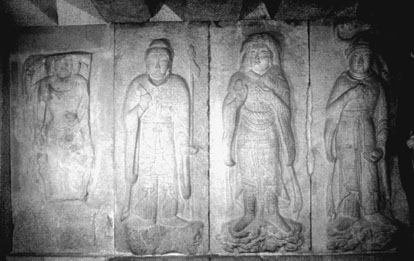

 | Page 771 |  |
for prehistoric and early historic Korea was composed, the study of which had been handicapped by the existence of few contemporary written records. The institutional and legal system for archaeological research established by the Japanese colonial government became the foundation for archaeological research in independent North and South Korea after World War II.

Bas relief on the wall of a Buddhist temple in Sokkuram, Korea
(Image Select)
However, Japanese archaeological research in Korea had a number of shortcomings, biases, and unfavorable side effects. Archaeological activities were strictly limited to Japanese scholars, and research institutions and museums never hired or trained Koreans. At the end of World War II, there was not a single Korean who had received any training at the innumerable excavations conducted by the Japanese. Archaeological reports and museum catalogs were printed in both Japanese and English, and occasionally in classical Chinese, but never in Korean.
The archaeological past of the Korean Peninsula apparently belonged only to the Japanese and not to the Koreans. Archaeological information was used to legitimize Japan’s colonial rule of Korea by highlighting alleged evidence of Japan’s past conquests of the peninsula and the presumed lack of indigenous developments in premodern Korea. The results of Japanese archaeological research were selectively used to highlight the common ancestral origins of the Korean and Japanese races, the assertion that Japanese emperors ruled Korea between the fourth and seventh centuries, the overwhelming influence of Chinese civilization on Korea and the consequent lack of unique Korean origins, and the backwardness and stagnation of Korean civilization (Hatada 1981). Archaeological knowledge was not used to illustrate the distinctive nature and original development of Korean prehistoric or historic culture.
After conducting thousands of surveys and excavations in Korea, the Japanese left behind only a few excavation reports, monographs, catalogs, and articles. Many of the excavations were simply treasure-hunting expeditions conducted without any scientific record-keeping. It is unfortunate that precious archaeological information was lost forever as a consequence. There is no primary archaeological data from the sites the Japanese considered to be the most important and worthy of their excavation.
 |  |